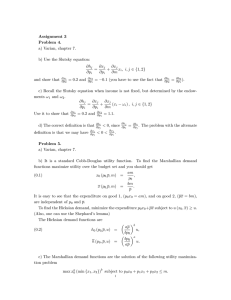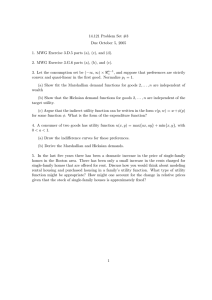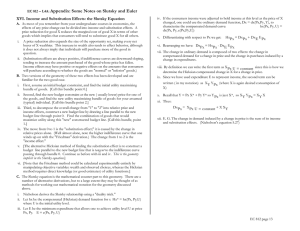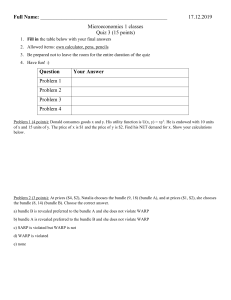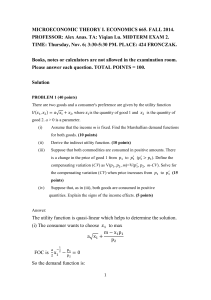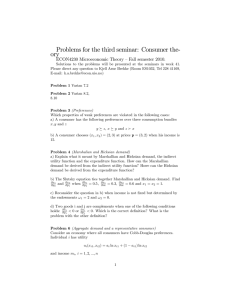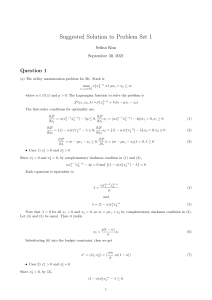Econ 316 Problem Set 1: Consumer Theory & General Equilibrium
advertisement
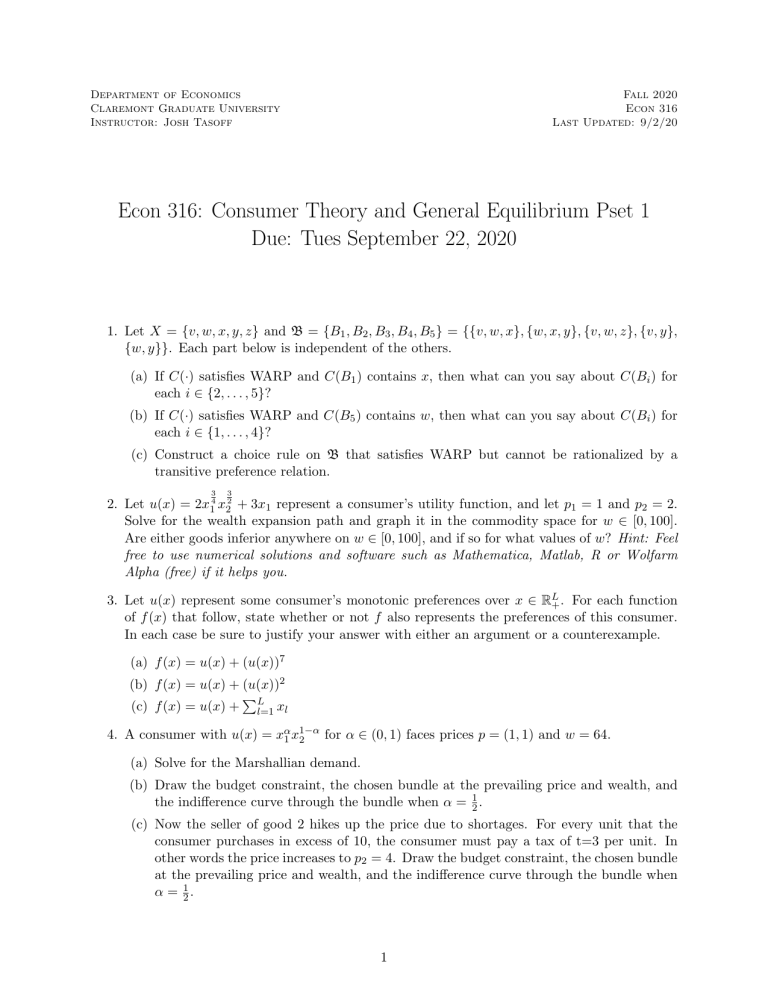
Fall 2020
Econ 316
Last Updated: 9/2/20
Department of Economics
Claremont Graduate University
Instructor: Josh Tasoff
Econ 316: Consumer Theory and General Equilibrium Pset 1
Due: Tues September 22, 2020
1. Let X = {v, w, x, y, z} and B = {B1 , B2 , B3 , B4 , B5 } = {{v, w, x}, {w, x, y}, {v, w, z}, {v, y},
{w, y}}. Each part below is independent of the others.
(a) If C(·) satisfies WARP and C(B1 ) contains x, then what can you say about C(Bi ) for
each i ∈ {2, . . . , 5}?
(b) If C(·) satisfies WARP and C(B5 ) contains w, then what can you say about C(Bi ) for
each i ∈ {1, . . . , 4}?
(c) Construct a choice rule on B that satisfies WARP but cannot be rationalized by a
transitive preference relation.
3
3
2. Let u(x) = 2x14 x22 + 3x1 represent a consumer’s utility function, and let p1 = 1 and p2 = 2.
Solve for the wealth expansion path and graph it in the commodity space for w ∈ [0, 100].
Are either goods inferior anywhere on w ∈ [0, 100], and if so for what values of w? Hint: Feel
free to use numerical solutions and software such as Mathematica, Matlab, R or Wolfarm
Alpha (free) if it helps you.
3. Let u(x) represent some consumer’s monotonic preferences over x ∈ RL
+ . For each function
of f (x) that follow, state whether or not f also represents the preferences of this consumer.
In each case be sure to justify your answer with either an argument or a counterexample.
(a) f (x) = u(x) + (u(x))7
(b) f (x) = u(x) + (u(x))2
P
(c) f (x) = u(x) + L
l=1 xl
4. A consumer with u(x) = xα1 x1−α
for α ∈ (0, 1) faces prices p = (1, 1) and w = 64.
2
(a) Solve for the Marshallian demand.
(b) Draw the budget constraint, the chosen bundle at the prevailing price and wealth, and
the indifference curve through the bundle when α = 21 .
(c) Now the seller of good 2 hikes up the price due to shortages. For every unit that the
consumer purchases in excess of 10, the consumer must pay a tax of t=3 per unit. In
other words the price increases to p2 = 4. Draw the budget constraint, the chosen bundle
at the prevailing price and wealth, and the indifference curve through the bundle when
α = 12 .
1
Fall 2020
Econ 316
Last Updated: 9/2/20
Department of Economics
Claremont Graduate University
Instructor: Josh Tasoff
(d) A consumer with strictly convex preferences but unknown utility function faces the
budget from part (c). Is her Marshallian demand necessarily single-valued? Why or why
not?
1
5. A consumer has a utility function u(x) = (xρ1 + 23 xρ2 ) ρ for ρ 6= 0. For the following parts show
your work.
(a) Solve for the Marshallian demand function.
(b) Solve for the indirect utility function.
(c) When w = 24, p = (1, 1), and ρ = 0.5, are the goods gross complements or gross
substitutes?
(d) What bundle is consumed when ρ = −1, w = 24, and p = ( 12 , 1)?
6. A consumer has the same utility function as in Question 5.
(a) Solve for the Hicksian demand function using the EMP.
(b) Show that the Hicksian demand function satisfies the properties stated in Proposition
3.E.3.
(c) Solve for the expenditure function.
(d) Show that the expenditure function satisfies the properties stated in Proposition 3.E.2.
7. Using your results from Question 5(a), derive the Hicksian demand function using the Slutsky
equation and show that it is the same as your answer from 6(a). Construct the Slutsky matrix
for this utility function. Show that when ρ = 0.5 and w = 24 the Slutsky matrix is negative
semi-definite.
2
